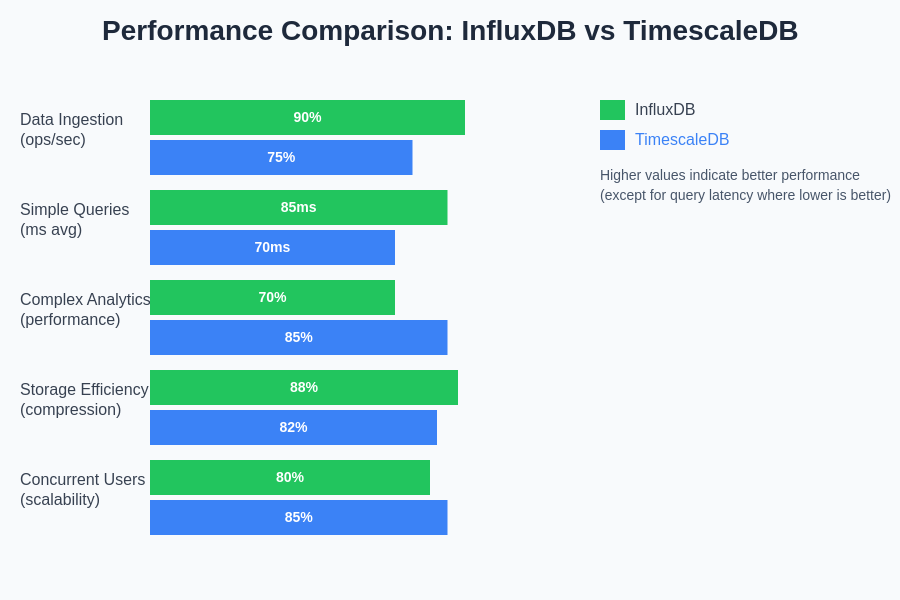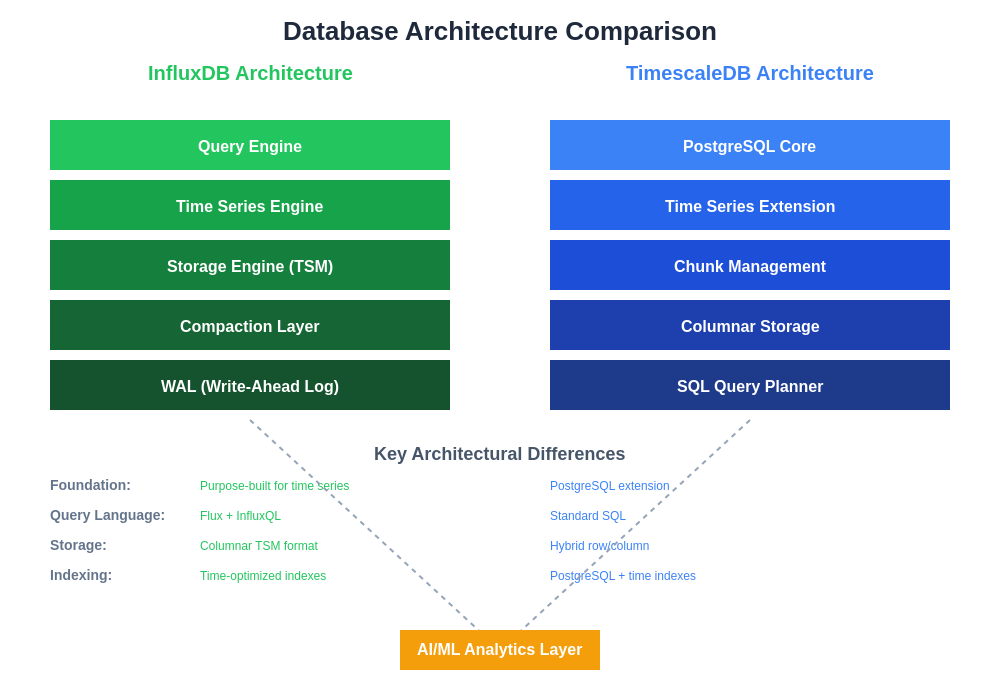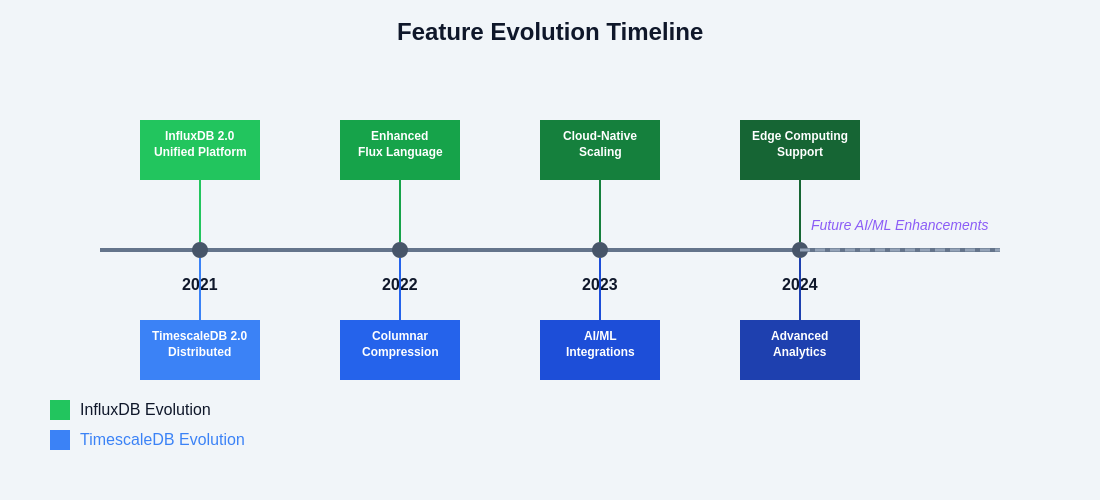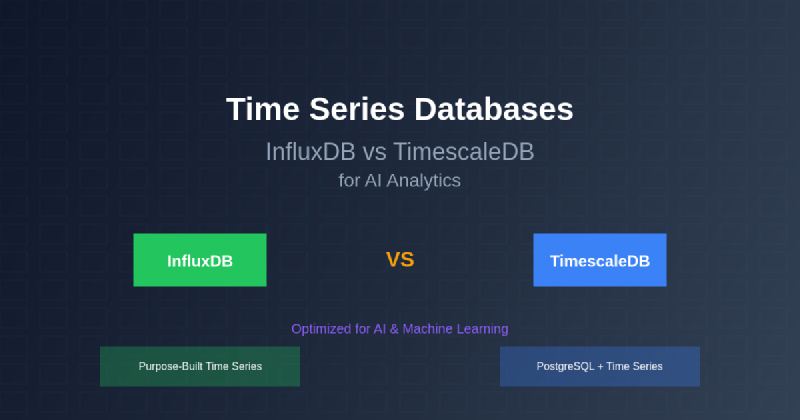The explosive growth of artificial intelligence and machine learning applications has created an unprecedented demand for sophisticated data storage solutions capable of handling massive volumes of time-stamped information. Time series databases have emerged as the cornerstone technology for managing AI analytics workloads, with InfluxDB and TimescaleDB leading the charge as the most prominent solutions in this rapidly evolving landscape. Understanding the nuanced differences between these two powerhouse platforms is crucial for organizations seeking to optimize their AI infrastructure and unlock the full potential of their temporal data assets.
Explore the latest developments in AI and database technologies to stay informed about cutting-edge trends that are reshaping the intersection of data management and artificial intelligence. The choice between InfluxDB and TimescaleDB extends far beyond simple feature comparisons, encompassing critical considerations around performance characteristics, scalability patterns, integration capabilities, and long-term strategic alignment with evolving AI workloads.
The Evolution of Time Series Data in AI
The integration of time series databases into AI analytics represents a fundamental shift in how organizations approach temporal data management and machine learning pipeline architecture. Traditional relational databases, while robust and feature-rich, struggle to efficiently handle the high-velocity, high-volume characteristics of time series data that are inherent to modern AI applications. This limitation has driven the development of specialized database systems that are purpose-built to excel in scenarios involving continuous data streams, real-time analytics, and complex temporal queries.
InfluxDB and TimescaleDB have emerged as the leading solutions in this space, each taking distinctly different architectural approaches to address the challenges of time series data management. InfluxDB represents a purpose-built time series database that has been designed from the ground up to optimize for temporal data patterns, while TimescaleDB extends the familiar PostgreSQL ecosystem with time series-specific enhancements that leverage decades of relational database optimization and tooling maturity.
The significance of this choice becomes apparent when considering the diverse requirements of AI analytics workloads, which often involve complex data preprocessing pipelines, real-time feature engineering, model training on historical data, and continuous monitoring of model performance metrics. Each database brings unique strengths and architectural philosophies that can dramatically impact the efficiency and scalability of these critical AI operations.
InfluxDB Architecture and AI Integration
InfluxDB’s architecture reflects a ground-up approach to time series data management, incorporating native concepts such as measurements, tags, fields, and timestamps that align naturally with the structure of temporal data common in AI applications. This purpose-built design enables InfluxDB to achieve exceptional performance characteristics for time series workloads through optimized storage engines, compression algorithms, and query processing mechanisms specifically tailored for temporal data patterns.
The database’s schemaless design provides significant flexibility for AI applications that often deal with evolving data structures and dynamic feature sets. Machine learning pipelines frequently require the ability to adapt to changing data schemas as new sensors are added, feature engineering processes evolve, or model requirements change over time. InfluxDB’s native support for these dynamic scenarios reduces the operational overhead associated with schema migrations and enables more agile development practices in AI projects.
Experience advanced AI capabilities with Claude to enhance your database architecture planning and optimization strategies for complex time series workloads. The integration capabilities of InfluxDB with modern AI frameworks and tools have been significantly enhanced through comprehensive APIs, client libraries, and integration packages that facilitate seamless data flow between the database and machine learning pipelines.
TimescaleDB’s PostgreSQL Foundation Advantage
TimescaleDB’s approach to time series data management leverages the mature PostgreSQL ecosystem while introducing specialized optimizations for temporal workloads. This architectural decision provides immediate access to decades of PostgreSQL development, including advanced indexing strategies, complex query optimization, transaction management, and extensive third-party tooling support that can significantly accelerate AI project development and deployment.
The SQL compatibility of TimescaleDB represents a substantial advantage for organizations with existing PostgreSQL expertise and infrastructure investments. AI teams can leverage familiar SQL syntax and existing database administration practices while benefiting from time series-specific optimizations such as automatic partitioning, columnar compression, and temporal indexing strategies. This compatibility extends to the vast ecosystem of PostgreSQL extensions, analytics tools, and integration frameworks that have been developed over many years.
The hybrid approach of TimescaleDB enables organizations to maintain both time series and relational data within a unified database platform, eliminating the complexity and overhead associated with managing multiple database systems. This architectural simplification is particularly valuable for AI applications that require joining temporal data with reference tables, user information, configuration data, or other relational structures that are common in enterprise environments.
Performance Characteristics for AI Workloads
The performance profiles of InfluxDB and TimescaleDB exhibit distinct characteristics that make each solution more suitable for different types of AI analytics workloads. InfluxDB’s purpose-built architecture typically delivers superior performance for high-frequency data ingestion scenarios, real-time analytics queries, and operations that align closely with native time series patterns. The database’s optimized storage engine and compression algorithms can achieve remarkable space efficiency while maintaining fast query response times for temporal aggregations and time-based filtering operations.
TimescaleDB’s performance characteristics reflect its PostgreSQL foundation, delivering exceptional performance for complex analytical queries that involve joins, subqueries, and advanced SQL operations. The database excels in scenarios where AI applications require sophisticated data transformations, complex feature engineering operations, or integration with existing relational data structures. The mature query optimizer inherited from PostgreSQL provides sophisticated execution planning capabilities that can effectively handle complex analytical workloads common in machine learning applications.

The performance comparison reveals that both databases excel in different operational scenarios, with InfluxDB demonstrating superior ingestion rates and simple query performance, while TimescaleDB shows advantages in complex analytical operations and mixed workload scenarios that are common in comprehensive AI analytics platforms.
Scalability Patterns and Architectural Considerations
Scalability requirements for AI analytics applications often involve both horizontal and vertical scaling patterns, depending on the specific characteristics of the workload and the growth patterns of the underlying data. InfluxDB’s clustering capabilities provide native support for distributed deployments that can scale across multiple nodes to handle increasing data volumes and query loads. The database’s sharding strategies and replication mechanisms are specifically designed to accommodate the append-heavy characteristics of time series workloads while maintaining consistency and availability requirements.
TimescaleDB’s scalability approach leverages PostgreSQL’s proven replication and clustering technologies while introducing time series-specific optimizations such as automatic chunk-based partitioning and distributed query processing. The database’s ability to scale both compute and storage resources independently provides flexibility for AI workloads that may have varying requirements for processing power and data retention. The integration with cloud-native deployment patterns and container orchestration platforms facilitates elastic scaling strategies that can adapt to changing workload demands.
The choice between these scalability approaches often depends on the specific characteristics of the AI application, including data ingestion patterns, query complexity, retention requirements, and availability constraints. Organizations with primarily append-heavy workloads and simple temporal queries may find InfluxDB’s native clustering more aligned with their needs, while those requiring complex analytical operations and integration with existing PostgreSQL infrastructure may benefit from TimescaleDB’s hybrid approach.
Data Modeling and Schema Design for AI Applications
The approach to data modeling and schema design represents a fundamental difference between InfluxDB and TimescaleDB that can significantly impact the development and maintenance of AI analytics applications. InfluxDB’s measurement-based data model encourages a denormalized approach that aligns naturally with the structure of sensor data, metrics, and other temporal information sources common in AI applications. This model simplifies the process of storing and querying time series data but may require careful consideration when dealing with complex relational structures or evolving data requirements.
TimescaleDB’s relational model provides greater flexibility for complex data relationships while maintaining time series optimizations through specialized indexing and partitioning strategies. This approach enables AI applications to maintain normalized data structures where appropriate while leveraging temporal optimizations for time series queries. The ability to seamlessly integrate time series data with traditional relational structures can simplify the overall application architecture and reduce the complexity of data pipeline implementations.
Leverage Perplexity’s research capabilities to stay current with evolving best practices in time series data modeling and AI analytics architecture design. The schema evolution capabilities of each database present different trade-offs in terms of flexibility, performance, and operational complexity that should be carefully evaluated based on the specific requirements and growth expectations of the AI application.
Integration with Machine Learning Frameworks
The integration capabilities of time series databases with popular machine learning frameworks and tools represent a critical consideration for AI analytics applications. InfluxDB provides comprehensive client libraries and APIs that support seamless integration with Python-based machine learning ecosystems, including NumPy, Pandas, Scikit-learn, TensorFlow, and PyTorch. The database’s native support for data export formats commonly used in machine learning pipelines reduces the friction associated with data preparation and feature engineering processes.
TimescaleDB’s PostgreSQL compatibility provides immediate access to a mature ecosystem of database connectivity tools and ORM frameworks that are widely used in machine learning applications. The database’s support for advanced SQL operations enables complex feature engineering and data transformation operations to be performed directly within the database, potentially reducing the computational overhead and complexity of external data processing pipelines.
Both databases offer integration capabilities with popular data pipeline orchestration tools such as Apache Airflow, Prefect, and Dagster, enabling the development of sophisticated ETL processes that can support complex AI workflows. The choice between databases often depends on the specific integration requirements of the organization’s existing technology stack and the preferred patterns for data flow and processing in their machine learning pipelines.
Monitoring and Observability for AI Systems
The monitoring and observability capabilities of time series databases play a crucial role in maintaining the health and performance of AI analytics systems. InfluxDB provides native monitoring and alerting capabilities through its integrated ecosystem, including visualization tools, dashboards, and notification systems that can track database performance, data quality metrics, and application-specific KPIs. These capabilities are particularly valuable for AI applications that require continuous monitoring of model performance, data drift detection, and system health metrics.
TimescaleDB leverages the extensive monitoring and observability tools available in the PostgreSQL ecosystem while adding time series-specific monitoring capabilities. The database’s compatibility with popular monitoring solutions such as Prometheus, Grafana, and various PostgreSQL monitoring tools provides flexibility in implementing comprehensive observability strategies. The ability to create custom monitoring queries using standard SQL can simplify the development of application-specific monitoring and alerting systems.

The architectural differences between InfluxDB and TimescaleDB result in distinct approaches to monitoring and observability, with each database providing unique advantages for different monitoring scenarios and organizational preferences.
Cost Considerations and Resource Optimization
The cost implications of choosing between InfluxDB and TimescaleDB extend beyond simple licensing considerations to encompass operational expenses, infrastructure requirements, and long-term maintenance overhead. InfluxDB’s purpose-built architecture can achieve significant storage and computational efficiency for time series workloads, potentially reducing infrastructure costs through optimized resource utilization. However, the specialized nature of the database may require additional expertise and tooling investments that should be factored into the total cost of ownership calculations.
TimescaleDB’s PostgreSQL foundation can leverage existing organizational expertise and infrastructure investments, potentially reducing the learning curve and operational overhead associated with database administration and maintenance. The availability of managed cloud services for both databases provides alternatives that can shift operational responsibilities to service providers while potentially optimizing costs through economies of scale and specialized expertise.
The cost optimization strategies for each database involve different considerations around data retention policies, compression strategies, and query optimization techniques. Organizations should carefully evaluate their specific usage patterns, performance requirements, and growth projections to make informed decisions about the most cost-effective approach for their AI analytics infrastructure.
Security and Compliance for AI Data
Security and compliance considerations for AI analytics applications often involve complex requirements around data protection, access control, audit trails, and regulatory compliance that must be carefully addressed in the database selection and implementation process. InfluxDB provides comprehensive security features including authentication, authorization, encryption at rest and in transit, and audit logging capabilities that can support enterprise security requirements and regulatory compliance obligations.
TimescaleDB inherits the mature security framework of PostgreSQL, including advanced authentication mechanisms, row-level security, column-level encryption, and comprehensive audit logging capabilities. The database’s compatibility with established PostgreSQL security practices and third-party security tools can simplify the implementation of comprehensive security strategies for AI applications handling sensitive or regulated data.
Both databases support integration with enterprise identity management systems, single sign-on solutions, and external authentication providers that are commonly required in enterprise AI deployments. The choice between databases may depend on specific security requirements, existing security infrastructure, and the complexity of the access control patterns required by the AI application.
Backup and Disaster Recovery Strategies
The backup and disaster recovery capabilities of time series databases represent critical considerations for AI analytics applications that rely on historical data for model training, validation, and continuous learning processes. InfluxDB provides native backup and restore capabilities that are optimized for time series data characteristics, including incremental backup strategies and point-in-time recovery options that can minimize data loss and recovery time objectives.
TimescaleDB leverages PostgreSQL’s mature backup and recovery ecosystem, including continuous archiving, point-in-time recovery, and streaming replication capabilities that have been proven in enterprise environments over many years. The database’s compatibility with established PostgreSQL backup tools and practices can simplify the implementation of comprehensive disaster recovery strategies.
The specific backup and recovery requirements for AI applications often involve considerations around data retention policies, recovery time objectives, recovery point objectives, and the criticality of different data sets to ongoing AI operations. Both databases provide the technical capabilities to meet enterprise-grade backup and recovery requirements, but the implementation approaches and operational considerations may vary based on the chosen platform.
Future Roadmaps and Technology Evolution
The future development trajectories of InfluxDB and TimescaleDB reflect different strategic approaches to evolving time series database capabilities and addressing emerging requirements in the AI analytics space. InfluxDB’s roadmap focuses on enhancing native time series capabilities, improving cloud-native deployment options, and expanding integration with modern AI and analytics frameworks. The database’s continued evolution as a purpose-built time series solution positions it to address increasingly sophisticated temporal analytics requirements.
TimescaleDB’s development roadmap leverages ongoing PostgreSQL enhancements while introducing time series-specific innovations that can benefit from the broader PostgreSQL community and ecosystem development. The database’s hybrid approach enables it to incorporate advances in both relational database technology and specialized time series optimizations, potentially providing a best-of-both-worlds solution for complex AI analytics requirements.

The evolution of both databases continues to be driven by changing requirements in the AI and analytics space, including support for edge computing scenarios, improved real-time processing capabilities, enhanced integration with cloud services, and advances in automated optimization and management capabilities.
Making the Right Choice for Your AI Analytics Platform
The decision between InfluxDB and TimescaleDB for AI analytics applications requires careful consideration of multiple factors including current requirements, future growth expectations, existing technical capabilities, and strategic technology alignment. Organizations with primarily time series-focused workloads, high-frequency data ingestion requirements, and preferences for specialized database solutions may find InfluxDB’s purpose-built approach more aligned with their needs and objectives.
Conversely, organizations with complex analytical requirements, existing PostgreSQL expertise, mixed workload patterns, or preferences for leveraging established ecosystem investments may benefit more from TimescaleDB’s hybrid approach. The specific characteristics of the AI application, including data volumes, query complexity, integration requirements, and operational constraints, should guide the evaluation process and inform the final decision.
The success of either choice ultimately depends on proper implementation, optimization, and ongoing management practices that align with the specific requirements and constraints of the AI analytics application. Both databases provide robust capabilities that can support sophisticated AI workloads when properly configured and optimized for the specific use case requirements.
Conclusion and Strategic Recommendations
The landscape of time series databases for AI analytics continues to evolve rapidly, with both InfluxDB and TimescaleDB representing mature and capable solutions that can effectively support sophisticated AI analytics workloads. The choice between these platforms should be based on a comprehensive evaluation of technical requirements, organizational capabilities, strategic alignment, and long-term objectives rather than simple feature comparisons or performance benchmarks.
Organizations embarking on AI analytics initiatives should consider conducting proof-of-concept implementations with both databases to evaluate their suitability for specific workloads and requirements. This hands-on evaluation approach can provide valuable insights into the practical implications of each choice and help identify potential challenges or advantages that may not be apparent from theoretical comparisons alone.
The continued evolution of both platforms promises ongoing enhancements in performance, scalability, and integration capabilities that will further expand their applicability to emerging AI analytics use cases. Staying informed about these developments and maintaining flexibility in database architecture decisions can help organizations adapt to changing requirements and take advantage of new capabilities as they become available.
Disclaimer
This article is for informational purposes only and does not constitute professional advice. The views expressed are based on current understanding of database technologies and their applications in AI analytics. Readers should conduct their own research and testing to evaluate the suitability of different database solutions for their specific requirements. Database performance and capabilities may vary depending on specific use cases, deployment configurations, and workload characteristics.
